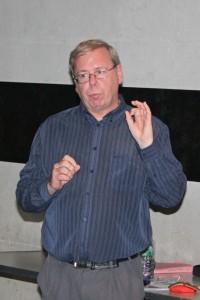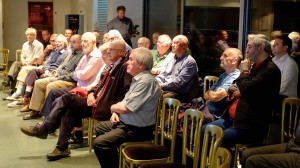September 30, 2014
Longitude and the Victorian Internet – History of Astronomy Group Meeting
Bill Connor
Report by: Mike Dryland
The mainstay of our History Group programme has been the impressive knowledge and talent of our own members. Bill’s talk added significantly to this growing tradition – Bill has special insights into the history of the telegraph network, the ‘Victorian Internet’, and he linked these to the development of Longitude determination and the ties to Greenwich in the story.
Bill began with a reminder of the Longitude problem and 2014’s commemoration of the 1714 Longitude prize. He pointed out that the successful early methods relied on finding the local time difference between two places – each hour’s difference is the same as 15 degrees longitude. The early astronomical method developed in Greenwich, using the moon’s apparent position, did well to find longitude within 30 miles accuracy, maybe sufficient for mariners at sea but not enough to satisfy needs as precision surveying and charting developed.
After about 1800 chronometers could deliver better accuracy but high-precision measurements required the physical movement of ‘assemblages’ of dozens of chronometers between the places to be mapped and still failed to satisfy the demand. It was the appearance of the galvano-magnetic telegraph from 1840 that offered the hope of a ‘miracle’ solution – here was a way to send messages instantaneously (almost) from place to place and enable the time difference between the places to be found at once.
Bill turned back to the origins of the telegraph in 18th century semaphore systems. He moved on to describe how the galvano-magnetic (electric) telegraph was conceived and got its kick-start from inventors and entrepreneurs, especially Samuel Morse in the US, and Cooke and Wheatstone in Britain. Bill explained the technical problems that had to be overcome and compared the competing systems.
The needs of commerce drove the development and laying of transatlantic cables. The early effort was a disaster, but after the US Civil War the influence of William Thompson (later Lord Kelvin) provided a sound technical base on which to build. The transatlantic cable had two significant ties to Greenwich ––the cable was manufactured in Greenwich, and laid by Brunel’s Great Eastern (the only ship large enough to carry the continuous length of cable needed) itself built on the River Thames right opposite Greenwich.
Bill traced the development of international telegraph networks across the globe – driven predominantly by the needs and resources of the British Empire. British links were mainly undersea cables due to political considerations – cables over foreign lands were vulnerable to cutting and tapping by enemies in times of war or international tension – an opportunity well exploited by the British themselves who controlled much of the international cable capacity and could tap into messages from other countries!
Looking again at longitude determination, Bill told how pioneering work using the electric telegraph took place in the USA led by the US Coastal Survey. Bill explained the different techniques which were used employing telegraph links and how accuracy increased as the technical issues were ironed-out. Soon the British Astronomer Royal, George Airy, had to concede that the ‘American method’ was superior to chronometric determination. Airy threw his efforts into collaborating with the US to get high precision longitude determinations between US and European cities. By the end of the 19th century the telegraph could deliver time differences accurate to 6 milliseconds. US surveyors were using the network to correct charts of the Pacific region across the ocean’s island groups to the Phillippines.
In passing Bill mentioned one more Greenwich connection – in the survey of British India, ‘the Great Arc’, a leading role was played by one George Everest (pronounced Eve-rest) who grew up in Greenwich – he is now remembered, of course, in the name of a large mountain (pronounced Ev-er-est)!
The Flamsteed audience was fascinated by the twists and turns and breadth of Bill’s tale. The evening (pronounced eve-ning) ended with a lively Q&A and Bill was assisted by a colleague from the cable industry to field several technical questions about modern hardware.
Great fun! A super evening. Many thanks and well done Bill!
Pictures from the Evening (by Mike Dryland and Mike Meynell):
Posted under: Flamsteed, History of Astronomy, Meeting Report









You must be logged in to post a comment.